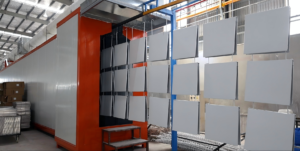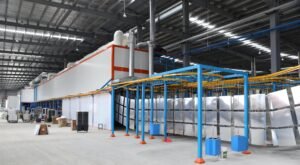Powder coating is a widely used finishing process that provides a durable, attractive, and environmentally friendly coating for metal products. To achieve a high-quality and long-lasting finish, the powder coating process must be executed carefully through several essential stages. Understanding each stage helps manufacturers optimize quality, reduce defects, and extend the life of the coated product. This article explores the five critical stages of powder coating, explaining why each step is necessary for a durable finish. Throughout the article, we will reference the advanced capabilities of Ketu’s Powder coating line to illustrate how modern systems ensure precision and efficiency in each phase.

Stage 1: Pre-treatment – Cleaning and Surface Preparation
The foundation of a successful powder coating job begins with thorough pre-treatment. This stage involves cleaning and preparing the metal surface to ensure the powder adheres properly and the finish lasts.
Why Pre-treatment is Crucial
- Removal of Contaminants: Oils, grease, dirt, rust, mill scale, and old coatings must be completely removed. Any residue can cause adhesion failure, leading to peeling or flaking.
- Surface Profiling: Techniques like shot blasting or sandblasting create a slightly roughened surface profile that improves mechanical bonding.
- Corrosion Resistance: Applying chemical treatments such as phosphate coatings enhances corrosion resistance and improves the powder’s ability to bond with the metal.
Typical Pre-treatment Steps
- Cleaning: Using alkaline or acidic cleaners to degrease and remove contaminants.
- Rinsing: Multiple rinses with clean water to remove cleaning agents.
- Chemical Treatment: Applying iron or zinc phosphate coatings to create an ideal base layer.
- Drying: Ensuring the surface is completely dry before powder application.
Ketu’s Powder coating line integrates automated pre-treatment systems that deliver consistent cleaning and surface preparation, minimizing human error and maximizing throughput.

Stage 2: Powder Application
Once the surface is properly prepared, the powder coating is applied. This stage is the heart of the process where the finish begins to take shape.
How Powder Application Works
- Electrostatic Spray: Powder particles are electrostatically charged (usually negatively), while the metal part is grounded. This causes the powder to be attracted and adhere evenly to the surface.
- Uniform Coverage: The electrostatic charge helps the powder wrap around complex shapes and recesses, ensuring complete coverage.
- Thickness Control: The application aims for a uniform thickness, typically around 3-5 mils, which balances durability and appearance.
Equipment and Techniques
- Spray guns with adjustable voltage and flow rates.
- Automated robotic arms for consistent, repeatable application.
- Manual spray booths for smaller or custom jobs.
Ketu’s advanced Powder coating line features cutting-edge electrostatic spray technology, enabling precise control over powder flow and charge for superior finish uniformity.

Stage 3: Curing
After the powder is applied, the coated parts must be cured to transform the powder into a solid, durable finish.
The Curing Process Explained
- Heating: The coated item is placed in a curing oven, typically heated between 180°C and 210°C (356°F to 410°F).
- Melting and Flowing: The powder melts and flows out, filling in gaps and creating a smooth surface.
- Cross-linking: Chemical reactions occur that cross-link the polymer chains, forming a tough, hard finish.
Importance of Proper Curing
- Durability: Proper curing ensures resistance to chipping, scratching, and fading.
- Chemical Resistance: Fully cured coatings withstand exposure to chemicals and weather.
- Adhesion: Curing bonds the coating firmly to the substrate.
Ketu’s Powder coating line includes energy-efficient curing ovens with precise temperature controls to optimize curing times and energy consumption.
Stage 4: Cooling
Once curing is complete, the parts must be cooled before handling or further processing.
Why Cooling Matters
- Finish Stability: Cooling solidifies the coating, locking in the finish properties.
- Handling Safety: Allows parts to be handled safely without damaging the finish.
- Dimensional Stability: Prevents warping or distortion caused by residual heat.
Cooling can be natural (air cooling) or assisted with fans or conveyors designed to speed the process without compromising quality.
Ketu’s Powder coating line incorporates optimized cooling zones to ensure efficient throughput while protecting finish integrity.

Stage 5: Quality Inspection and Packaging
The final stage ensures that the coating meets all quality standards before shipment or installation.
Key Inspection Criteria
- Visual Inspection: Checking for uniformity, color consistency, and surface defects.
- Thickness Measurement: Ensuring coating thickness is within specification.
- Adhesion Testing: Verifying the coating bonds properly to the substrate.
- Durability Tests: Optional tests for hardness, impact resistance, and corrosion protection.
Packaging for Protection
- Protective wraps or coatings may be applied to prevent damage during transport.
- Proper labeling and documentation accompany the finished parts.
Ketu’s Powder coating line integrates automated inspection systems and customized packaging solutions to deliver products ready for immediate use or shipment.
Summary Table: 5 Stages of Powder Coating and Their Importance
| Stage | Purpose | Key Activities | Impact on Finish Quality |
|---|---|---|---|
| Pre-treatment | Surface cleaning and preparation | Cleaning, rinsing, chemical treatment, drying | Ensures adhesion, corrosion resistance, and uniform coating |
| Powder Application | Applying powder coating evenly | Electrostatic spray, manual or automated application | Achieves uniform coverage and desired thickness |
| Curing | Solidifying and bonding coating | Heating in curing oven, melting, cross-linking | Provides durability, chemical resistance, and adhesion |
| Cooling | Stabilizing the finish | Air or forced cooling | Prevents damage, ensures dimensional stability |
| Quality Inspection & Packaging | Verifying finish quality and protection | Visual and mechanical tests, protective packaging | Guarantees defect-free, ready-to-use products |
Conclusion
Each stage in the powder coating process plays a vital role in producing a durable, high-quality finish. From meticulous surface preparation to precise powder application, controlled curing, careful cooling, and rigorous inspection, every step contributes to the longevity and appearance of the coated product. Choosing a reliable and technologically advanced Powder coating line like those provided by Ketu ensures these stages are executed with precision and efficiency, delivering superior results that meet the demands of modern industry.
For companies seeking to enhance their finishing capabilities, understanding and investing in each stage of the powder coating process is essential to achieving excellence and customer satisfaction. Explore Ketu’s range of powder coating solutions to find the perfect system tailored to your production needs.

